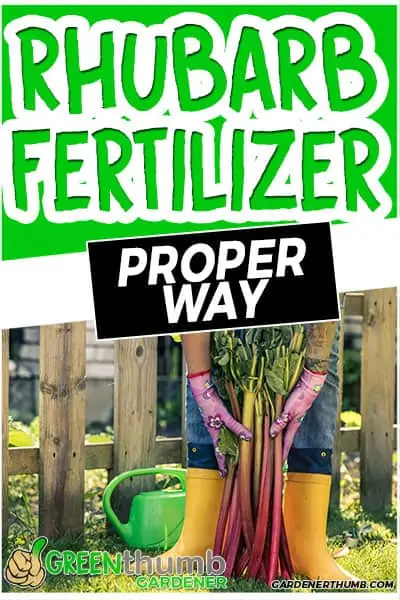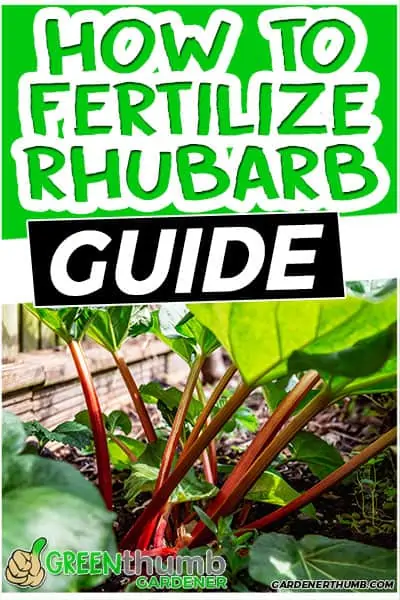Fertilizer For Rhubarb Beginner Tips
Last updated: 06/04/21
Rhubarb is a nutritious, easy-to-grow vegetable that is famous for its edible red, pink, or greenish stalks and is often used in tarts, jams, and pies like the strawberry-rhubarb pie. The red stalks are more popular in pies compared to the green stalks with their slightly grayish color when cooked.
Rhubarb is a perennial vegetable that can grow its edible stalks for many years. It grows easily and you can easily have a Rhubarb patch in your garden.
Although the tart flavored leaf stalk is edible, the Rhubarb leaves are toxic and contain oxalic acid, which is poisonous to humans and animals.
Green thumb Gardener occasionally links to product and/or services offered by vendors to assist you with all your gardening needs. Some of these may be affiliate links, meaning we earn a small commission if items are purchased.
Want to Download a Garden Hack Guide for FREE

Enter your email below and we will send you a guide to help you SAVE money in your garden.
When Is The Best Time To Fertilize Rhubarb
The Rhubarb plant’s yield and harvest quality will depend on much care, its food reserves and amount of nutrients it receives. The best time to fertilize Rhubarb is after one year after planting or in its second year.
You have to fertilize it in spring when you see the red bulbs emerging from the soil. Then fertilize it again in the fall to aid Rhubarb growth. It is highly advised not to fertilize newly planted Rhubarb.
What is The Best Fertilizer to Use for Rhubarb
You can use an all-purpose garden fertilizer with a 10-10- 10 fertilizer formula. You can also use compost or well-rotted manure as fertilizers.
Commercial fertilizers like granular fertilizers can be used following the manufacturer’s instructions or about 1 1/2 pounds for every 100 square feet.
Just be careful not to sprinkle them directly on the plant.
Granular fertilizer is usually placed in a circle around the plant to aid in the absorption of nutrients. Placing them directly on the plant will damage and burn the plants.
If you use water-soluble commercial fertilizer, you can apply the fertilizer by watering the plant using a sprayer or bucket.

How Often To Fertilize the Rhubarb
For the highest possible yields & possibly a giant rhubarb plant, you must fertilize it at least three times per year. Fertilizing will ensure a bountiful harvest and steady Rhubarb production.
You can apply two to three inches of composted manure or all-purpose garden fertilizer.
Broadcast at least 1/2 cup of an all-purpose garden fertilizer around each plant then work it lightly into the soil.
Growing Rhubarb & Keeping Them Healthy
Conditions For Rhubarb
Rhubarb plants grow very well in cold climates and typically need a few years to grow and produce their huge Rhubarb stalks. The Rhubarb plant was originally from Asia and was brought in the 1600s to Europe.
It was also eventually taken to the US by European settlers. It was once grown for its medicinal properties, but now mostly enjoyed as a sweet treat.
When is the Best Time to Plant Rhubarb?
Rhubarb grows best in areas with cold weather and requires an extended chilling period to produce large stalks per plant. The best time to plant is during early spring once the soil thaws and becomes more workable.
At this time, Rhubarb roots are still dormant and are beginning to grow their leaves. You can also plant during fall after dormancy has set in.
It is also possible to grow Rhubarb from seed. But it’s not recommended since it will take more time before you can have a good harvest.
Rhubarb is a perennial plant that can only be harvested after a few years after planting. You can typically use Rhubarb crowns or budded pieces instead of seeds to hasten the planting process.
Crowns are established Rhubarb plants that are at least a year old. Harvesting can take place two years after planting the Rhubarb crowns, and it will take longer if you grow them from seeds.
How to Plant Rhubarb?
Soil preparation is essential. Your crop of Rhubarb needs a moist, fertile, well-drained soil and sunny location. You can prepare the ground by mixing several inches of compost or organic material.
After preparing the site, dig individual planting holes two to three inches deep. Place the top of the crowns at least one inch below the soil surface. But if you are gardening in heavy clay soils, you can place them a little higher so the crowns will not rot.
Heavy soils can be improved by adding organic matter like kitchen compost or manure. Organic matter can improve soil drainage, preserve the soil structure, and lower the risk of root rot.

Make sure to work heavier soils deeply and add enough compost before planting.
The Rhubarb plant can grow into a large plant, so you have to make sure there is at least thirty to thirty-six inches distance between them. When the weather gets too hot, you place a 2-inch layer of straw to prevent the evaporation of soil moisture.
Water the Rhubarb plant regularly to make sure the soil stays moist and maintains healthy foliage. Inadequate water supply will significantly affect the health and development of your garden vegetable including the Rhubarb plant.
A healthy plant can store a significant amount of food in its roots and will result in a good harvest. Deeply soak the plants every seven to ten days throughout the dry weather especially during high summer temperatures.
How Do You Keep Them Healthy?
- Cover the ground with mulch made from well-rotted manure compost to keep it free from perennial weeds. But be careful not to cover the crown so that it will not rot. Prompt action is essential, so you must remove the rot by cutting them immediately.
- If you see signs of snails or slugs eating your young Rhubarb seedlings, control them by using traps, eggshell barriers, copper tape, and other biocontrols. Be on the lookout for other insect pests and try to control them right away.
- Established Rhubarb plants need to be divided every five to ten years, especially when the stems become thin and crowded. The best time to divide is during fall or early spring when the plants are dormant
- Watch out for leaf spot diseases and make the necessary interventions. Cut old foliage to prevent leaf spots
- Watch for pests like Rhubarb stalk borer, which can cause damage by puncturing the stalks. Control this pest by removing the grassy weeds in the garden where they lay their eggs
- Look for flowering Rhubarb stalks and remove them immediately. They take a lot of energy from the growing plant. It can lead to loss of vigor and affect the entire Rhubarb plant
- You have to observe plants that are five years old and older because they tend to have more flowering stalks. These flower stalks often appear due to extreme heat or cold, infertile soil, drought, or exposure to too much light

Further Reading
Harvesting Rhubarb
Make sure to allow the crown and root of the Rhubarb plant to develop before you harvest stalks. This means you have to wait two years after planting before you can harvest.
Harvest season starts on the third season and makes sure you only harvest for a 4-week harvest period. But full harvesting will start only in the fourth year.
You have to wait until the harvestable Rhubarb stalks have reached the right size of about ten to fifteen inches long.
The normal harvest season should only be eight to ten weeks and end in mid-June. You should not remove more than 2/3 of the fully developed stalks of a mature Rhubarb plant. This will ensure that the plants are not weakened by too much harvesting of stalks.
When harvesting, grab the base of the stalk and then pull it away from the plant with a slight twist. You can also use a clean sharp knife to cut the stalks at the base to prevent the spread of disease in the remaining stalks. Do not forget to discard the leaves properly.
Final Thoughts
Rhubarb is easy to plant and can produce a low-calorie vegetable that can be made into jams, jellies, puddings, etc. But remember that only the stalks should be eaten because the leaves are poisonous and contain oxalic acid.
Make sure to safely dispose of the discarded leaves and keep them away from children and animals.
Related Questions
What are the problems with rhubarb flower stalks?
The flower stalks take a lot of energy to produce, thereby they reduce plant vigor and next year’s production.








